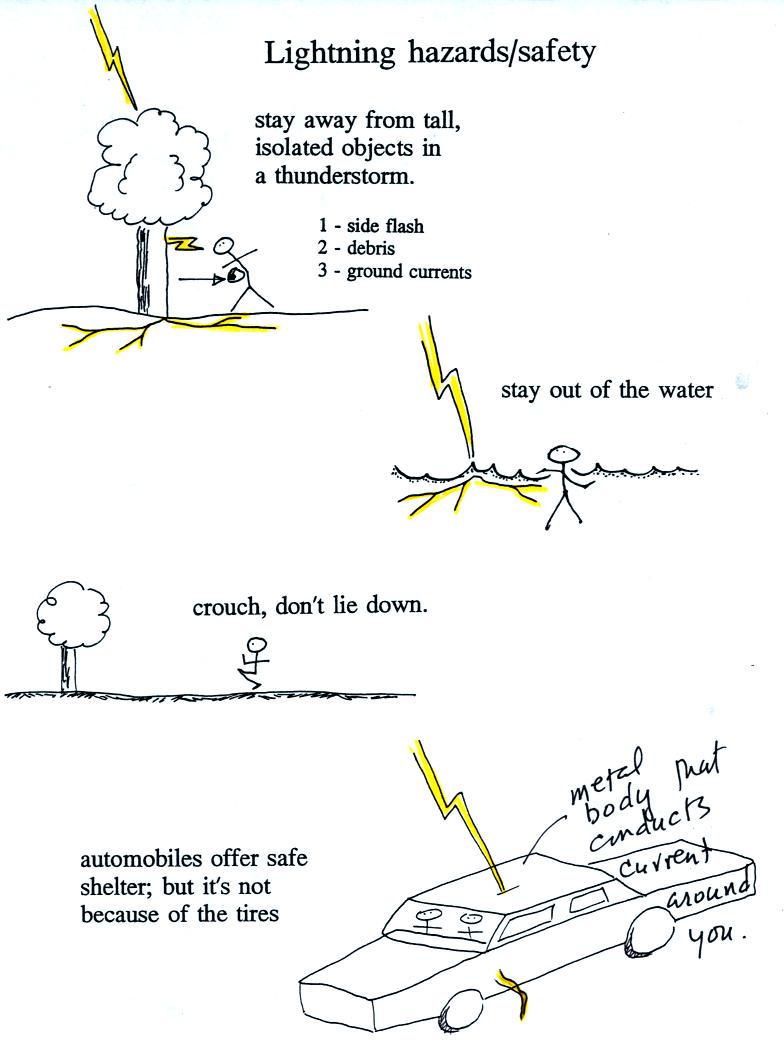Monday Nov. 29, 2010
Three songs from the Monsters
of
Folk ("The Sandman, The Brakeman, and Me", "Say Please", and
"Map of the World")
A little bit of lightning material to finish up today.
Lightning is a serious weather hazard and kills just under
100
people every year in the United States. We discussed some
lightning safety rules that you should keep in mind during
thundery weather.
Stay
away
from
tall
isolated
objects
during
a
lightning
storm.
You can be hurt or killed just by being close to a lightning strike
even if you're
not struck directly.
An
automobile
with
a
metal
roof and body provides good
protection from
lightning. The lightning current will travel through the metal
and around the passengers inside. The rubber tires really don't
play any role at all. The people in Florida that were
triggering lightning with rockets (shown on a video last week) were
inside a metal trailer and were perfectly
safe. All of the connections made to equipment outside the
trailer were done using fiber optics, there were no metal wires
entering
or leaving the trailer.
You shouldn't use a corded phone or electrical
appliances
during a lightning storm because lightning currents can follow wires
into your home. Cordless phones and cell phones are safe.
It is also a good idea to stay away from plumbing as much as possible
(don't take a shower during a lightning storm, for example). Vent
pipes that are connected to the plumbing go up to the roof of the
house which puts them in a perfect location to be struck.
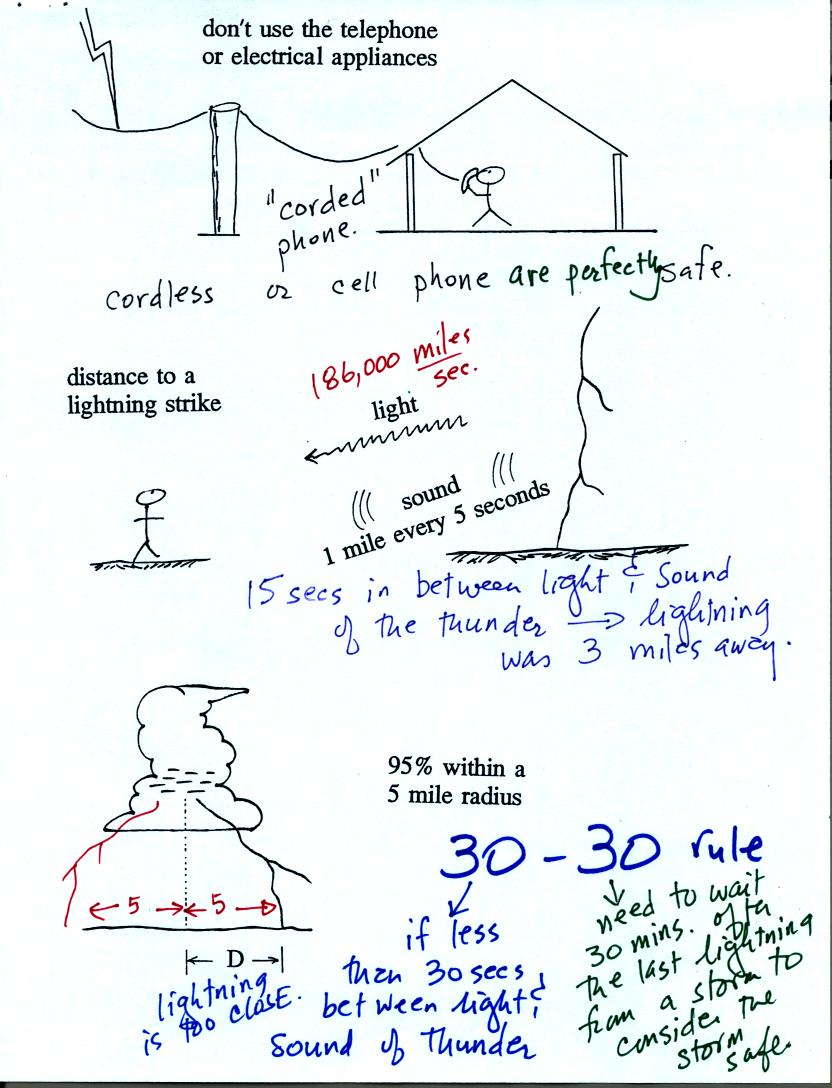
The latest lightning safety recommendation is the
30/30 Rule.
The 30/30 rule
People should seek shelter if the delay between
a lightning flash and its
thunder is 30 seconds or less.
People should remain under cover until
30 minutes after the final clap
of thunder.
We
will
spend the rest of class today and class on Friday on Hurricanes.
This will be the final
topic
that we cover this semester. This won't be on this week's quiz
but will most likely be on the Final Exam.
A good place to begin is to compare hurricanes (tropical cyclones)
with
middle latitude storms (extratropical cyclones). The middle
column below list some similarities, the outer columns list differences.
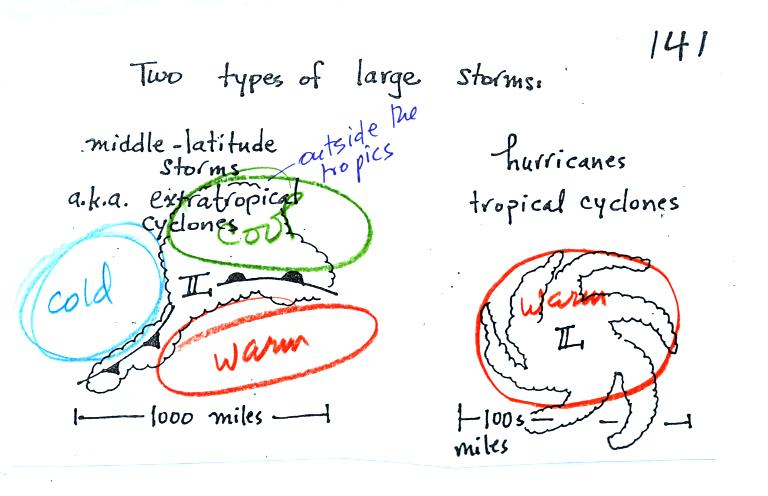
|
Middle latitude storms
|
Similarities
|
Hurricanes
|
1
|
form at middle latitudes
(30 to 60 degrees latitude)
|
both types of storms have
low pressure centers
(cyclone refers to winds blowing around low pressure)
|
from in the subtropics
(5 to 20 degrees latitude)
|
2
|
can form over land or water
|
upper level divergence is
what causes
both types of storms to intensify
|
only form over warm ocean
water
|
3
|
bigger (might cover half
the US)
|
|
not as big (might fill the
Gulf of Mexico)
|
4
|
fronts separate warm and
cold air masses
|
|
just warm moist air
|
5
|
at middle latitude the
prevailing westerly winds move these storms from west to east
|
|
the trade winds move
hurricanes from east to west
|
6
|
strongest in the winter
into early spring
|
|
strongest in late summer
into fall (when the ocean is warmest)
|
7
|
produce rain, snow, sleet,
graupel |
|
mostly just rain (lots of
rain) |
8
|
usually no name
|
|
get names
|
Hurricanes receive names (when they reach tropical storm
strength). The names now alternate male and female. The
names of particularly strong or deadly hurricanes (such as Katrina) are
retired, otherwise the names repeat every 6 years.
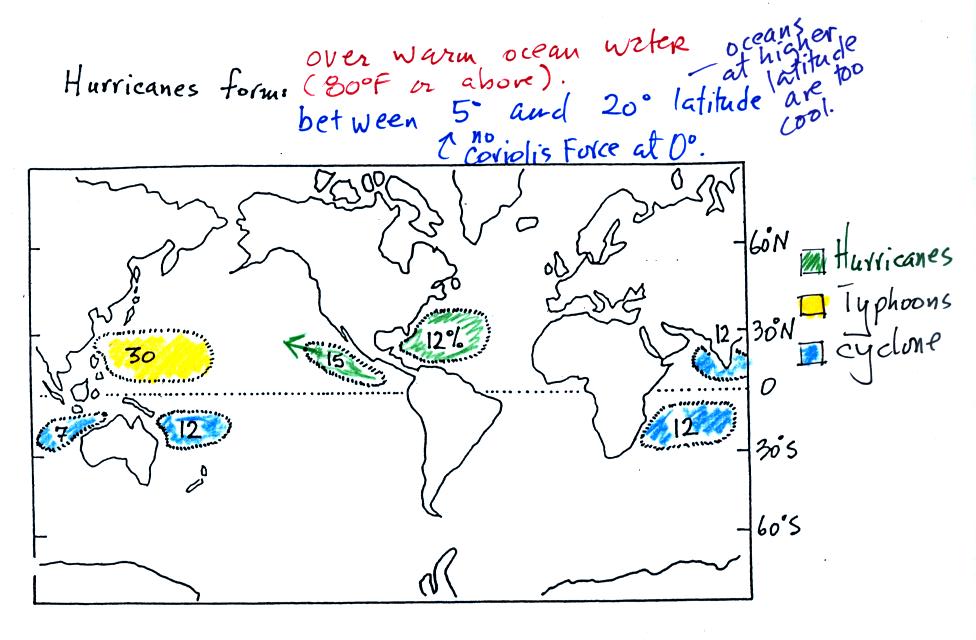
The figure above shows
the relative frequency of
tropical cyclone
development in different parts of the world.
The name hurricane, cyclone, and typhoon all refer to the same type of
storm (tropical cyclone is a general name that can be used
anywhere). In most years the ocean off the coast of SE Asia is
the
world's most active hurricane zone. Hurricanes are
very rare off
the east
and west coasts of South America.
Hurricanes form between 5 and 20 degrees latitude,
over warm ocean
water, north and south of the equator. The warm
layer of water
must be fairly deep to contain enough energy to fuel a hurricane and so
that turbulence and mixing don't bring cold water up to the ocean
surface. The atmosphere must be unstable so that thunderstorms
can develop. Hurricanes will only form when there is very little
or no vertical wind shear (changing wind direction or speed with
altitude). Hurricanes don't form at the equator because there is
no Coriolis force there (the Coriolis force is what gives hurricanes
their spin and it causes hurricanes to spin in opposite directions in
the northern and southern hemispheres).
Note that more tropical
cyclones form off the
west coast of the US than
off the east coast. The west coast hurricanes don't generally get
much attention, because they move away from the coast and usually
don't
present a threat to the US (except occasionally to the state of
Hawaii). The moisture from these storms will
sometimes be pulled up into the southwestern US where it can lead to
heavy rain and flooding.
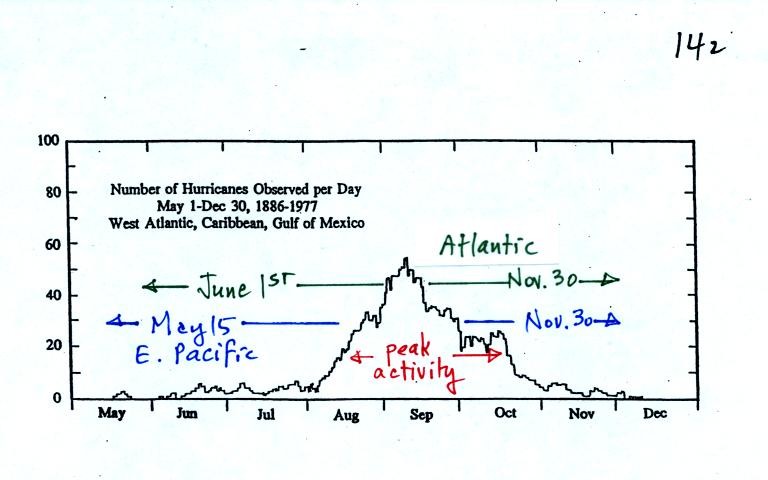
Hurricane season in the Atlantic
officially runs from
June 1 through to November 30. The peak of hurricane season is in
September. In 2005, an unusually active hurricane season in the
Atlantic, hurricanes continued through December and even into January
2006. Hurricane season in the Pacific begins two weeks earlier on
May 15 and
runs through Nov. 30.
